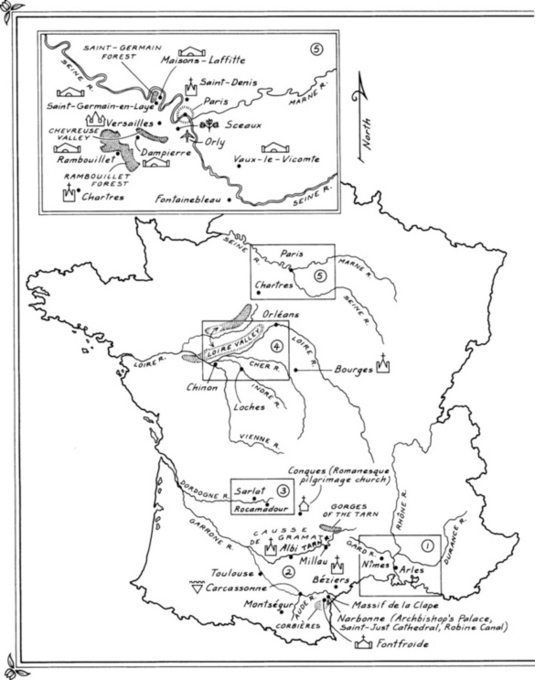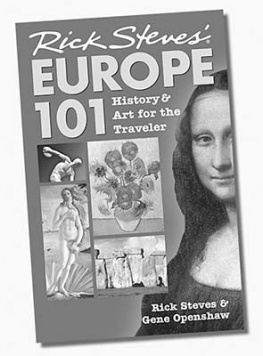PUBLISHED BY NAN A. TALESE
an imprint of Doubleday
a division of Bantam Doubleday Dell Publishing Group, Inc.
1540 Broadway, New York, New York 10036
D OUBLEDAY is a trademark of Doubleday, a division of
Bantam Doubleday Dell Publishing Group, Inc.
Map by Jackie Aher
Illustrations on by Martie Holmer
Chteau de Rocamadour by J. T. Arms: The Metropolitan Museum of Art, Gift of John Taylor Arms, 1942 (42.21.34); Bourges by J. T. Arms: The Metropolitan Museum of Art, Gift of John Taylor Arms, 1942 (42.21.29).
Blowin in the Wind by Bob Dylan. Copyright 1962 by Warner Bros. Music. Copyright renewed 1990 by Special Rider Music. All rights reserved. International copyright secured. Reprinted by permission.
Library of Congress Cataloging-in-Publication Data Caro, Ina.
The road from the past: traveling through history in France Ina Caro. 1st. ed.
p. cm.
Nan A. Talese.
1. FranceGuidebooks. 2. Historic sitesFranceGuidebooks.
I. Title.
DC16.C37 1994
914.404839dc20
9334636
eISBN: 978-0-307-81404-3
Copyright 1994 by Ina Caro
All Rights Reserved
v3.1
FOR BOB


ACKNOWLEDGMENTS
I would like to express my thanks to all who have helped me in one way or another to write this book: to my editor and publisher, Nan A. Talese for her enthusiasm and belief in this book; to my copy editor, Bob Daniels; to my agent, Wendy Lipkind Black; to Marion Fourestier at the French Government Tourist Office; to Katherine Hourigan; to Cynthia Cupples; and to Nancy Evans. However, I can never adequately thank Robert A. Caro, my husband and my traveling companion on all but one of my trips to France these past seventeen years. When I told him my idea of driving through history in Franceoriginally from the Roman ruins of Provence to the World War II invasion beaches in Normandyhe was skeptical but drove. Afterward he thought it was such a great way to travel that he urged me to write this book and helped me every step of the way. Without his advice, encouragement, and unwavering faith in me, this book would not have been possible. As his researcher on The Power Broker, The Path to Power, and Means of Ascent, I learned the importance of visiting places you write about. As my husband and traveling companion, he has turned every one of our trips into a magical experience. This is not an age when prince charmings, idealistic knights, and true love at first sight are taken seriously. When I was still in my teens, I fell in love with Bob, and he has been my prince charming for over thirty years. And I want to thank him for never once changing into a frog, and for visiting with me the castle of Sleeping Beauty which lies in an enchanted valley filled with a thousand castles and food so magical that fish and asparagus taste better than cake.
CONTENTS
INTRODUCTION
PT AND PALACES
M ost people return from Europe with a memory of the places they have visited that is very much like a salad after it has been put through a Cuisinart. They have been to so many countries and heard so many dates and names of kings that when they return, the trip is all a blur. When I see the typical American tourist, I feel like yelling out, Dont do it that way, its no fun. Do it my way.
If you do it my way, you will rent a time machineavailable at any rent-a-car agencyand drive through history. Our time machine cant take us into the future any faster than a minute at a time, but we can, if we properly plan our route, actually simulate the sensation of traveling through several centuries of the past on a magical vacation in France. If you follow the route I describe from Provence to Paris, traveling to some of the most magnificent and beautiful monasteries, churches, chteaux, and towns built in France over a period of nearly two thousand years, and visit these sites in the order they were built, you will feel almost as if you are traveling through the past, through the history of France.
To an American, a tour of this type may seem like whimsy, not only because our history is relatively short, and Americans generally have little sense of history anyway, but also because we have simply leveled too much of our pastto make way for newer, more profitable buildingsfor us to travel from one age to another. But it does work in France, where coliseums, cathedrals, keeps, fortresses, and castles decorate the landscape of a Frenchmans life and are concrete reminders of his historical and cultural past. France is so abundant in such remembrances, so rich in a past that is forever embedded in the present, that we are able, while traveling there, to transform dry memories of facts gleaned from books into substance and reality.
I have found that there are only three essential rules to follow to create the sensation of traveling through the past. The first is to visit sites in chronological order. The order in which we see the sites is as important, if not more important, than the sites themselves. If on our road map we place an overlay of time, really a route we will follow which takes us to the sites in the order of their constructionarranging our visits to temple and fortress, palace and chteau so that we begin with those structures built earliest and continue architecturally through the agesas we travel we cannot help but feel the flow of years passing by rather than the miles. The reason we feel this flow of time is this: architecture has evolved. One period has developed from another. The architecture of ancient Rome became Romanesque. The Romanesque style evolved into the Gothic, the Gothic into the Renaissance, and the Renaissance into the Mannerist and the Baroque. Each style incorporated certain aspects of its predecessor and eliminated those aspects which had become unnecessary or undesirable.
For example, as we travel through time, we can see arches change. We see the grandiose rounded Roman arch, created to overawe, slowly transformed into the austere rounded arch of the early Christian Church; transformed again from austerity and simplicity to the elaborate storytelling beauty of the twelfth-century Romanesque arch; and then, at the very pinnacle of this beauty, transformed again into the simple Gothic archwhich again evolves over the years from simplicity to flamboyance. Not only does the architecture of the Church change during our travels through the centuries, but so, too, does secular architecture. The somber fortress, encircled by ramparts and moats, with its narrow slits in the walls for defending archers (the only openings to the outside world and to light), its battlements for crossbowmen to stand behind, its machicolations from which other defenders could pour boiling water and hot oil, its watchtowers where sentries awaited besieging knights with their catapults, battering rams, and assault towersa fortress like Chinon, Castelnaud, or Beynacchanges with the years. As we travel through time, from one castle to another, we see the walls open up to light and air. The moats become mere decorations and then landscaped reflecting pools created to delight the eye rather than to defend against attacking Vikings, Magyars, Saracens, or another nobles knights. At first the battlements are retained as fantasy designs, and then they disappear altogether. We see the awkward proportions of feudal castles dissolve into harmony and perfect proportions during the Renaissance, then change again in the seventeenth century, when the castles of kings were meant to impress and overwhelm, when the French monarchy was at its height. We can, in fact, see the growth of royal absolutism mirrored in these castles. Visit Chinon, Loches, Langeais, Amboise, Blois, Chambord, Fontainebleau, and Versailles in the order in which they were built, and know only that these were the successive residences of the Kings of France, and you will understandquite deeplywhat is meant by the growth of French absolutism.

















